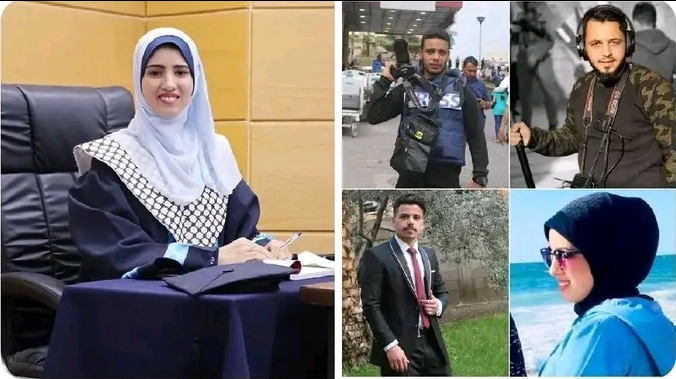At least five Palestinian journalists have been confirmed killed in a new wave of Israeli air strikes across the Gaza Strip, further compounding what press freedom advocates are calling the deadliest conflict for journalists in modern history.
On Sunday, Al Jazeera Arabic reported that three journalists had been confirmed dead following the latest bombardments, while Ramy Abdu, a prominent Palestinian financial analyst and human rights advocate, identified two additional victims.
The deceased were named as Aziz al-Hajjar, Nour Qandil, Abdul Rahman al-Abadleh, Khaled Abu Seif, and Ahmad Al-Zinati.
The Quds News Network reported that Aziz al-Hajjar, a well-known journalist, perished alongside his wife and children after an Israeli air strike hit their home in the Bir an-Naaja area of northern Gaza.
Hajjar had previously reported extensively on the humanitarian crisis unfolding in the enclave and was known for his commitment to covering stories from some of Gaza’s most dangerous frontlines.
Nour Qandil, another journalist killed in the strikes, was reportedly targeted in Deir al-Balah in central Gaza. According to multiple sources, the air raid also claimed the lives of her husband and their infant daughter.
Qandil was recognized for her coverage of the war’s toll on women and children and had been contributing to local and regional news outlets despite increasingly dangerous conditions.
Meanwhile, the body of Abdul Rahman al-Abadleh, who had been missing for more than two days, was recovered from the rubble following a strike on al-Qarara in southern Gaza.
Quds News reported that Abadleh had been on assignment documenting displacement patterns and infrastructure damage in the area when the strike occurred.
Details surrounding the deaths of Khaled Abu Seif and Ahmad Al-Zinati remain limited, but local journalists confirmed their fatalities through press networks operating on the ground in Gaza.
These latest deaths bring the total number of Palestinian journalists and media workers killed since the war began on October 7, 2023, to more than 230, according to media watchdogs.
This staggering figure has made the Israel-Gaza war the deadliest conflict for journalists in recorded history, surpassing death tolls from previous wars in Iraq, Syria, and Afghanistan.
Press freedom organizations, including the Committee to Protect Journalists (CPJ) and Reporters Without Borders (RSF), have raised alarm over what they describe as a systematic targeting of media workers in Gaza.
They argue that the unprecedented scale of journalist deaths not only underscores the perilous working conditions in the enclave but also suggests an erosion of the principle of media neutrality in armed conflict.
Despite repeated international calls for the protection of journalists under international humanitarian law, field correspondents in Gaza say they are often left without adequate safety assurances or protective equipment.
Many operate in close proximity to high-risk areas due to their commitment to documenting the war’s human cost.
With communication infrastructure severely damaged and foreign media barred from entering Gaza independently, local journalists remain the only eyes and ears on the ground.
As such, each death further erodes the global community’s ability to access verified, firsthand information from the conflict zone.
The killing of these five journalists is not only a personal tragedy for their families and colleagues, but also a significant loss for journalism and the global record of this war.
The international community continues to urge all parties to respect the rights and safety of journalists, as enshrined in the Geneva Conventions and various international protocols.
As the war drags on with no immediate end in sight, the role of local journalists in documenting its realities grows ever more critical—and perilous.
Share This Post





